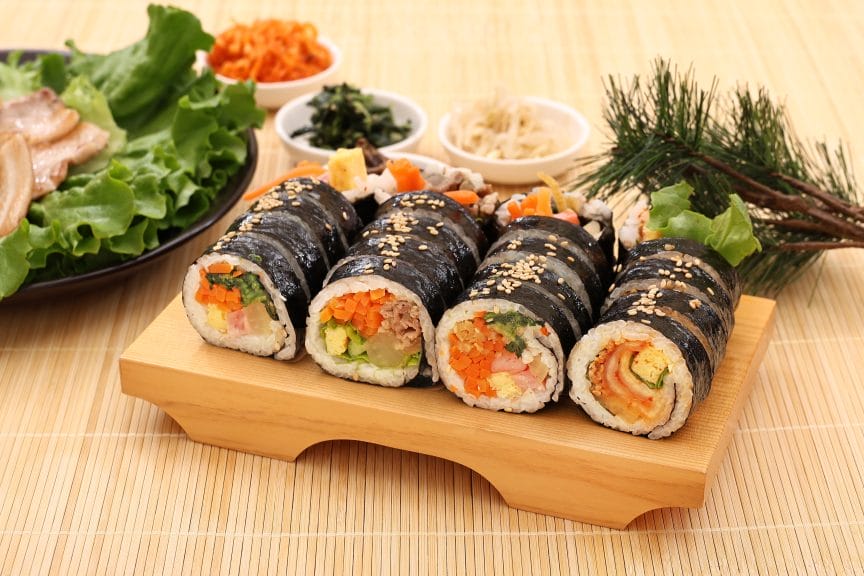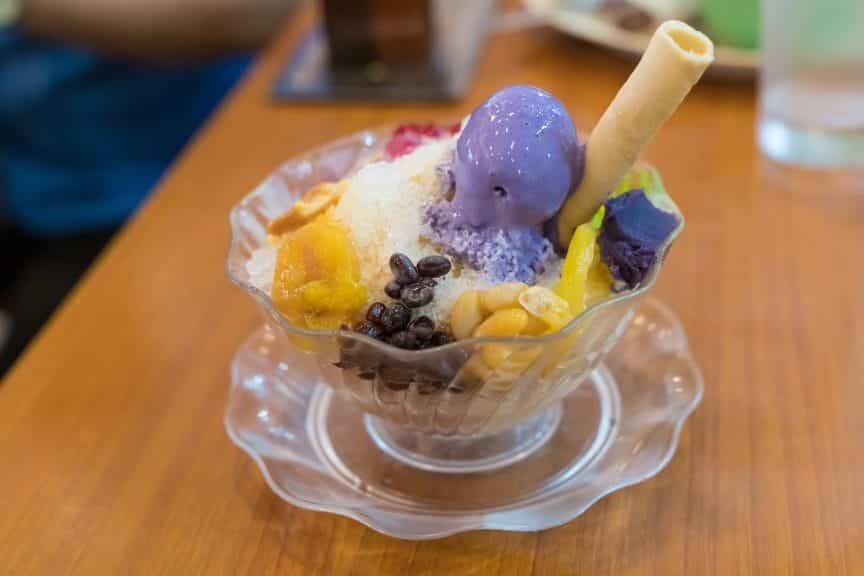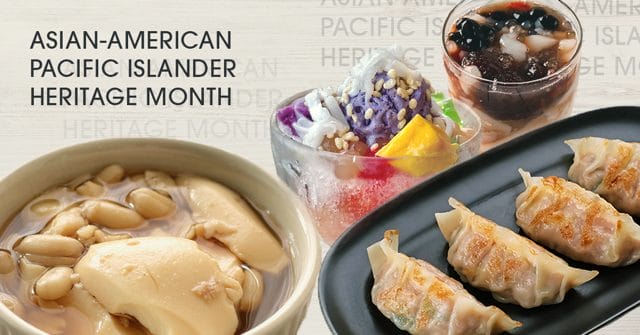In the United States, May is Asian-American and Pacific Islander (AAPI) Heritage Month, celebrating the peoples and cultures of the Asian continent and the islands of Micronesia, Melanesia, and Polynesia.
In some ways, dedicating a month to all of these cultures can seem a bit ambitious. Asia alone is the largest continent on the planet and home to over 4.5 billion people. How can we celebrate so many cultures under the same umbrella of a month? Perhaps the only fitting answer is through diversity itself, and one way of showing both diversity and unity is food.
Food is more than just physical nourishment: it represents care, family, and culture. The food of Asia and the Pacific Islands are just as diverse as the cultures themselves, so why not have a taste of what they have to offer?
In no particular order, here are some ideas for AAPI foods to explore this May. Try the recipes out yourself or support your local Asian and Pacific Island restaurants — or both!
Kimbap

At first glance they may look like sushi, but this Korean rice and seaweed roll has some important differences. Most notably, unlike sushi, kimbap does not feature raw fish. Instead, kimbap (also romanized as “gimbap”) is far more often filled with meat (sometimes canned tuna) and plenty of vegetables like carrot, kimchi, spinach, and danmuji, or pickled daikon radish.
Popular online Korean cook Maangchi shares a recipe for “Classic Gimbap” on her website. As she discusses, kimbap is a popular Korean food for outings, especially picnics, or as a simple school lunch.
“Many moms also send off their kids with an extra gimbap for their teachers, to express their thanks for the teacher’s hard work…you can imagine, some teachers end up with a lot of gimbap!”
Maangchi
Rajma
Rajma is a popular dish throughout the Indian subcontinent, particularly in Northern India, Pakistan, and Nepal. With red kidney beans as the main ingredient, rajma, along with several other South Asian dishes, is suitable for vegetarians.
Neytra Subramaniam shows how she makes the dish on BU Today, a news website of Boston University, as part of their series “Mama Meals,” where students share dishes that remind them of home.
“When my mom sends me food…it makes me very grateful because I’m not one to often cook, and I love and miss her food when I’m not home.”
Neytra Subramaniam
Murgir Lal Jhol
Murgir Lal Jhol is a Bengali dish of chicken and red curry, made with Kashmiri chilies and various spices and aromatics.
Bong Eats, a YouTube channel that shares traditional Bengali foods, features the dish in a recipe on their website. They emphasize the importance of fresh, quality ingredients for murgir lal jhol.
“It does away with everything but the essential… none of the usual spices such as coriander and cumin, and no garnishing with coriander leaves. Which means that the few ingredients that do go in, have to be fresh if you would like to achieve the best results.”
Bong Eats
Lūʻau, Palusami, Laing
These foods are part of a family of dishes throughout Polynesia and parts of Austronesia which use the large leaves of the taro plant. The leaves are often cooked with coconut milk and meat, such as corned beef, or seafood.
Dumplings
While they share similar names and forms, each culture has its own take on the classic dumpling.
- Mandu – Korean dumplings, with pork as a common filling, which may be steamed, fried, boiled, or included in soup like manduguk.
- Mantu – Afghan dumplings, usually served for special occasions, which is usually filled with beef and lamb.
- Manti – Dumplings popular throughout West and Central Asia, including Turkiye, Armenia, and Uzbekistan, and often filled with spiced ground beef or lamb.
- Momo – Tibetan and Nepali dumplings traditionally made with ground meat, but which also may be filled with vegetables, cheese, or khoa, a type of dried or thickened dairy product.
Douhua/Tào Phớ/Taho
Sometimes called tofu pudding or tofu brains, these are a family of sweet or savory foods whose main ingredient is silken tofu, a type of tofu with a soft, smooth texture. Savory versions may be flavored with ingredients such as soy sauce, chili, and nuts. Meanwhile, sweet versions — which are particularly common in Southeast Asia — are often served with syrup, ginger, pandan, or sago pearls.
Shaved Ice

Shaved ice is a common summer treat throughout Asia and the Pacific Islands, often flavored with syrups, ice cream, fruit, jelly, or sweet beans.
Some of these varieties of shaved ice have historical roots connections with one another, which can be seen in their general similarities. While these desserts share a base of ice and usually milk, they differ in the decoration of toppings.
- Kakigōri – Japanese shaved ice usually flavored with syrup and condensed milk. Popular flavors include matcha, strawberry, lemon, “Blue Hawaii” syrup, and simple syrup
- Bingsu/Bingsoo – Korean shaved ice dessert, often topped with condensed milk and fruit. Instead of a plain ice base, bingsu uses a shaved frozen milk base. The most common variety is patbingsu, or red bean bingsu. Other common flavors include strawberry, mango, injeolmi (roasted soybean powder), and Oreo
- Halo-halo – Filipino shaved ice dessert, meaning “mixed.” With a base of crushed ice and evaporated or coconut milk, halo-halo includes toppings like ice cream, ube halaya (mashed purple yam), beans, tapioca, and fruit.
- Namkhaeng Sai – Thai shaved ice with condensed milk. Vendors and restaurants typically offer a large selection of toppings, such as fruit, grass jelly, bread, and thapthim krop (water chestnuts colored bright red).
- Hawaiian Shave Ice/Ice Shave – A popular Hawaiian frozen dessert. It may be flavored with syrup only, or served with toppings such as ice cream, guava, pineapple, li hing mui (Chinese dried plums), or mango.
- Tsuah-ping/Baobing – Taiwanese shaved ice, also popular in mainland China, Malaysia, and Singapore. Common toppings are condensed milk, red or mung beans, tapioca, and seasonal fruit like strawberries and mango.
- Ais Kacang/ABC – Popular shaved ice dessert in Malaysia, Singapore, and Brunei. The most common ingredients are attap chee (palm seed), red beans, grass jelly, and nuts.
Embracing Canned And Pre-Made Foods
Never let exoticism fool you into thinking there are no cheap, easy-to-make meals for lazy night dinners when exploring other cuisines. At the same time, don’t think that these premade staples can’t be elevated into delightful meals.
Several AAPI cultures use canned and pre-made foods for a variety of dishes. One of the most common is Spam. Possibilities are endless, ranging from Spam fried rice to Spam musubi, a popular Japanese and Hawaiian snack of Spam and rice wrapped in seaweed.
Corned beef is another common canned staple, particularly in Southeast Asia and Polynesia. It can be used in dishes such as Samoan spaghetti or served as-is with white rice.
A classic, hearty homemade dinner, Japanese curry is almost always cooked with premade roux blocks as opposed to from-scratch spices. Just toss those cubes into a pot of boiling water and vegetables, simmer, and serve with rice.
Buddae jjigae, or Korean “army stew,” features canned and processed foods as its main ingredients, like Spam, sausage, and sliced American cheese.
Explore!
AAPI is an extremely broad label with a massive variety of cultures under its umbrella. With that variety comes an equally diverse range of unique foods and particular variations of common dishes, each adapted for the ingredients and palettes of each particular country. Food can be a great way of getting to know cultures other than your own, so celebrate AAPi month by exploring the different tastes of Asia and the Pacific Islands.
Related Articles:














